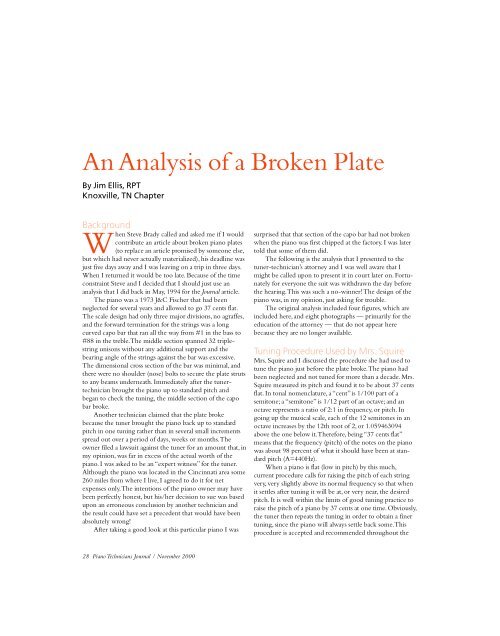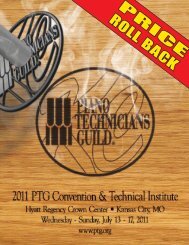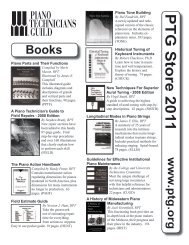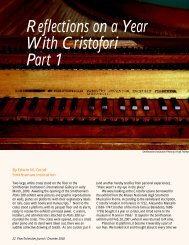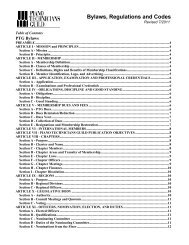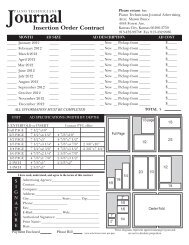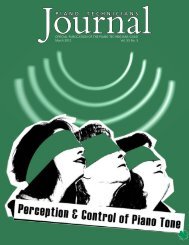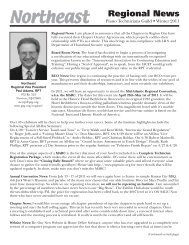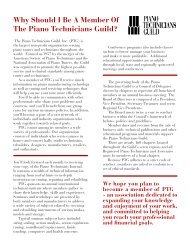Download PDF - Piano Technicians Guild
Download PDF - Piano Technicians Guild
Download PDF - Piano Technicians Guild
You also want an ePaper? Increase the reach of your titles
YUMPU automatically turns print PDFs into web optimized ePapers that Google loves.
An Analysis of a Broken Plate<br />
By Jim Ellis, RPT<br />
Knoxville, TN Chapter<br />
Background<br />
When Steve Brady called and asked me if I would<br />
contribute an article about broken piano plates<br />
(to replace an article promised by someone else,<br />
but which had never actually materialized), his deadline was<br />
just five days away and I was leaving on a trip in three days.<br />
When I returned it would be too late. Because of the time<br />
constraint Steve and I decided that I should just use an<br />
analysis that I did back in May, 1994 for the Journal article.<br />
The piano was a 1973 J&C Fischer that had been<br />
neglected for several years and allowed to go 37 cents flat.<br />
The scale design had only three major divisions, no agraffes,<br />
and the forward termination for the strings was a long<br />
curved capo bar that ran all the way from #1 in the bass to<br />
#88 in the treble. The middle section spanned 32 triplestring<br />
unisons without any additional support and the<br />
bearing angle of the strings against the bar was excessive.<br />
The dimensional cross section of the bar was minimal, and<br />
there were no shoulder (nose) bolts to secure the plate struts<br />
to any beams underneath. Immediately after the tunertechnician<br />
brought the piano up to standard pitch and<br />
began to check the tuning, the middle section of the capo<br />
bar broke.<br />
Another technician claimed that the plate broke<br />
because the tuner brought the piano back up to standard<br />
pitch in one tuning rather than in several small increments<br />
spread out over a period of days, weeks or months. The<br />
owner filed a lawsuit against the tuner for an amount that, in<br />
my opinion, was far in excess of the actual worth of the<br />
piano. I was asked to be an “expert witness” for the tuner.<br />
Although the piano was located in the Cincinnati area some<br />
260 miles from where I live, I agreed to do it for net<br />
expenses only. The intentions of the piano owner may have<br />
been perfectly honest, but his/her decision to sue was based<br />
upon an erroneous conclusion by another technician and<br />
the result could have set a precedent that would have been<br />
absolutely wrong!<br />
After taking a good look at this particular piano I was<br />
28 <strong>Piano</strong> <strong>Technicians</strong> Journal / November 2000<br />
surprised that that section of the capo bar had not broken<br />
when the piano was first chipped at the factory. I was later<br />
told that some of them did.<br />
The following is the analysis that I presented to the<br />
tuner-technician’s attorney and I was well aware that I<br />
might be called upon to present it in court later on. Fortunately<br />
for everyone the suit was withdrawn the day before<br />
the hearing. This was such a no-winner! The design of the<br />
piano was, in my opinion, just asking for trouble.<br />
The original analysis included four figures, which are<br />
included here, and eight photographs — primarily for the<br />
education of the attorney — that do not appear here<br />
because they are no longer available.<br />
Tuning Procedure Used by Mrs. Squire<br />
Mrs. Squire and I discussed the procedure she had used to<br />
tune the piano just before the plate broke. The piano had<br />
been neglected and not tuned for more than a decade. Mrs.<br />
Squire measured its pitch and found it to be about 37 cents<br />
flat. In tonal nomenclature, a “cent” is 1/100 part of a<br />
semitone; a “semitone” is 1/12 part of an octave; and an<br />
octave represents a ratio of 2:1 in frequency, or pitch. In<br />
going up the musical scale, each of the 12 semitones in an<br />
octave increases by the 12th root of 2, or 1.059463094<br />
above the one below it. Therefore, being “37 cents flat”<br />
means that the frequency (pitch) of the notes on the piano<br />
was about 98 percent of what it should have been at standard<br />
pitch (A=440Hz).<br />
When a piano is flat (low in pitch) by this much,<br />
current procedure calls for raising the pitch of each string<br />
very, very slightly above its normal frequency so that when<br />
it settles after tuning it will be at, or very near, the desired<br />
pitch. It is well within the limits of good tuning practice to<br />
raise the pitch of a piano by 37 cents at one time. Obviously,<br />
the tuner then repeats the tuning in order to obtain a finer<br />
tuning, since the piano will always settle back some. This<br />
procedure is accepted and recommended throughout the


